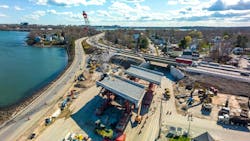Enhancing Bridge Work Zone Safety
By Travis Konda, Contributing Author
As owners, engineers, and contractors repair and modernize the nation’s bridge infrastructure, they battle an environment of steadily increasing traffic volumes.
Work zones on bridge construction sites often involve areas of significant pinch points and traffic congestion that increase the risk of crashes and worker injury.
One way to lessen the chances of these incidents is through the utilization of accelerated bridge construction (ABC).
With ABC’s focus on either rapid construction in-place or preassembled bridges completed at an off-alignment location and then moved into place, traffic disruptions to motorists can be reduced, as roadwork is done in a fraction of the time and long-term work zones are avoided.
With exposure to work zones reduced, the safety for the traveling public and construction workers is improved.
Shortening On-Site Construction time
When the bridge carrying Interstate-295 over Veranda Street in Portland, Maine, was due for replacement, conventional construction methods would have entailed building a large temporary bridge and temporarily closing the I-295 northbound offramp.
Daily traffic jams — which increase the likelihood of crashes — would have been the norm for the nearly 55,000 motorists who travel this busy stretch of I-295 each day.
Instead, the Maine Department of Transportation (MDOT) replaced the existing twin bridges in their entirety using ABC construction. Work began at 6:45 p.m. on a Friday. With the old bridge removed, self-propelled modular transporters (SPMTs) moved the new, single-span bridges into place, setting the spans down on new substructures that were built under the existing bridges while maintaining overhead interstate traffic.
By 6:45 a.m. the following Monday, the new bridge was in place, paved, striped and open to traffic.
Although the ABC approach still required an I-295 closure, the shutdown was limited to a single weekend. This eliminated up to four years of daily travel delays — and safety risks — on the interstate.
Limiting Workers’ Time
Using ABC, the Virginia Department of Transportation (VDOT) overcame a serious obstacle when the Virginia State Route 120 bridge over Pimmit Run superstructure needed to be replaced.
ABC allowed VDOT to reduce the overall time workers needed to be in the work zone.
VDOT fully closed and removed half of the bridge, using the existing superstructure for construction access to carry away the old bridge after cutting the deck and diaphragms, then setting the prefabricated superstructure elements.
The superstructure precast steel beam and slab units were joined with closure pours after these panels were placed.
Even with record-breaking flooding in the area that extended the construction timeline, the bridge reopened after only a 17-day closure.
The brief construction period, coupled with a full closure, minimized safety risks to workers, supported concurrent operations and prevented accidental interactions with motorists.
Minimizing Traffic Impacts
For the Northaven Trail Bridge project in Dallas, public safety was a priority for the Texas Department of Transportation
Consequently, a key project goal was to deliver the new, network tied-arch bridge with minimal impact to the traveling public. The agency required that a frontage road or a lane northbound and southbound on U.S. 75 — which carries roughly 250,000 vehicles daily — remain open throughout construction and that any main-lane closure period be limited to Saturday overnights.
Those requirements drove early design choices to employ accelerated bridge construction techniques, which would allow the bridge to be built off-site and moved into place.
The bridge deck, cables and arch were constructed as a single structure on timber shoring just to the east of the highway.
Utilizing remote-controlled SPMTs, the bridge was transported from its off-site location on a Friday and positioned roadside to U.S. 75. On Saturday, the SPMTs pivoted the 800,000-pound structure from its parallel position. Bridge gantries then placed the bridge in its final location.
While highway traffic was minimized for a few hours overnight, U.S. 75 was never fully closed to travelers. By Sunday afternoon, the bridge was in place and all U.S. 75 lanes were once again open. The bridge move took about 20 hours and required only about 14 hours of full closures.
One of ABC’s greatest benefits is that it dramatically shortens both drivers’ and construction workers’ exposure to work-zone hazards. As the infrastructure community addresses the repair or replacement of our nation’s aging bridges, accelerated bridge construction is an innovative method that can help reduce injuries and keep drivers and workers safe. RB
Travis Konda is a senior technical advisor at HNTB.
